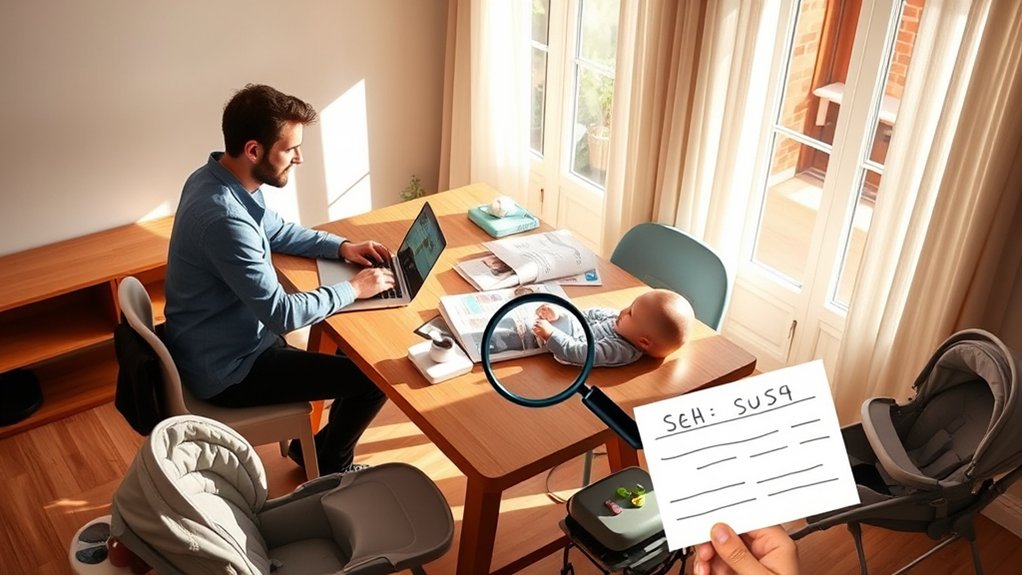Define your baby gear needs and focus on must-have features like terrain adaptability and safety. Hit reliable parenting sites, check user reviews, and compare brands for recalls and standards like JPMA. Analyze specs for weight, material, and ease of use. Check certifications and safety, prioritizing ASTM compliance. Balance costs with utilities and compare products. Don’t ignore the dad forums—they pack practical wisdom with dad jokes. To explore further into this critical acquisition, keep exploring.
Key Points
- Verify baby gear certifications like JPMA and ASTM for safety compliance and standards.
- Analyze material quality for durability, non-toxicity, and ease of assembly.
- Check gear specifications like weight capacity, foldability, and terrain adaptability.
- Compare user reviews for practical insights on performance and reliability.
- Evaluate compatibility between car seats and strollers for seamless transitions.
Define Your Requirements and Prioritize Features

Before you dive headfirst into the world of baby gear, start by defining your requirements—because without a clear target, you’re fundamentally shooting in the dark. Identify what you need from the baby gear guide. Prioritize the essentials.
- Stroller Research: Determine terrain adaptability, weight, and foldability. Ask yourself, will it fit in the car trunk?
- Car Seat Specs: Check safety features, weight limits, and installation ease. Is it compatible with your vehicle?
List must-haves versus nice-to-haves. This isn’t your average shopping trip; you’re selecting mission-critical equipment. Additionally, personalized nutrition strategies can play a crucial role in maintaining long-term wellness and vitality for both you and your baby. Consider using apps or digital tools to track and cherish these important milestones as they provide an enhanced way to monitor your baby’s progress. Remember that recognizing and responding to your baby’s hunger cues is vital in establishing a nurturing environment, which can help support a healthy feeding relationship.
Gather Data From Reliable Sources

You’ve identified your mission-critical baby gear needs; now, initiate the intel-gathering phase. Immerse yourself in reliable sources to determine what to buy for baby. Start with trusted parenting sites and consumer review platforms. Look for user-generated reviews; they’re the intel reports you need. Cross-check brands on safety standards and recall history, ensuring no red flags. Tap into dad forums for firsthand insights, but separate the wheat from the chaff. Maintaining a support network as you navigate these decisions can provide both emotional benefits and practical advice. Consult comparison sites for side-by-side specs; they’re your data dashboards. Additionally, consider researching what to expect during your first prenatal visit to ensure you’re fully prepared for this pivotal healthcare appointment. Remember, optimizing nutrition and comfort for both you and your baby is crucial, much like the importance of choosing the right gear.
Analyze Spec Sheets for Key Metrics

When analyzing spec sheets for baby gear, think of yourself as a mission analyst combing through critical data—every number, every feature, every material matters. Keep your focus sharp and your coffee hot. Here’s the tactical approach:
- Weight Capacity: Confirm the gear supports your growing mini-commander. Overlook this, and risk a critical mission failure.
- Material Quality: Look for durable, non-toxic materials. Your baby deserves a fortress, not a paper house.
- Ease of Assembly: Review assembly instructions. You’re not assembling a space shuttle, but it shouldn’t feel like it. Regular check-ins and open dialogue with co-founders can ensure that your business decisions align with shared goals and values, much like ensuring baby gear aligns with your family’s needs. Incorporating soothing algorithms into your decision-making could optimize the selection process, making it less stressful and more efficient.
Additionally, understanding your child’s unique readiness and cues can be crucial when selecting potty training gear, as it ensures that the equipment aligns with their developmental stage and needs.
Compare Performance Benchmarks

Examine stroller maneuverability metrics and car seat safety ratings as if you’re evaluating a tactical vehicle’s agility and armor resilience. Prioritize metrics like wheel swivel capabilities and impact test results, since your little co-pilot deserves the best in both comfort and safety. Additionally, consider the convenience and practicality of having a compatible car seat and stroller, ensuring seamless transitions from car to stroller without disturbing a sleeping baby. It’s important to understand the balance between essential fat and excessive storage, as maintaining a healthy body composition can impact the overall comfort and safety of both you and your baby during these transitions. For a touch of humor and to keep spirits high during your research and shopping, mastering dad jokes can be beneficial, as they create laughter and connection across generations.
Stroller Maneuverability Metrics
Before you deploy funds for a stroller, understanding maneuverability metrics is essential. Think of it as evaluating the agility of your favorite tech gadget. You’re not just pushing a stroller; you’re piloting a precision device.
Consider these crucial specs:
- Turning Radius: Check the stroller’s ability to navigate tight spaces. A smaller radius equals smoother cornering.
- Wheel Suspension: Look for advanced suspension systems, ensuring a ride smoother than your dream car.
- Wheel Size and Type: Larger wheels mean better terrain handling. Opt for all-terrain wheels for versatility.
Choose wisely, and your stroller will glide like it’s on rails.
Car Seat Safety Ratings
How crucial is it to understand car seat safety ratings? Well, consider them the CPU benchmarks of your baby gear acquisition. You wouldn’t install outdated processors in your rig, would you? So, study those ratings like a spec sheet. Safety ratings offer a comparative analysis of car seats, ensuring your little co-pilot rides in the safest seat possible. In the early stages of fatherhood, setting boundaries between work and family responsibilities can be challenging, but prioritizing safety in your baby’s gear is a non-negotiable part of that balance. The importance of GPU innovations in enhancing computational efficiency is akin to how vital safety ratings are in ensuring the well-being of your child. Here’s a quick reference table:
| Feature | Importance Level | Considerations |
|---|---|---|
| Crash Test Score | High | Look for top ratings |
| Ease of Use | Medium | User-friendly installation is a must |
| Material Quality | High | Durable and non-toxic materials |
| Adjustability | Medium | Accommodates growth |
| Price | Low | Balance cost with safety features |
Don’t cut corners; safety is non-negotiable. Additionally, understanding the importance of consistent sleep schedules can also play a role in ensuring both parent and child have restful, restorative sleep, which is crucial for overall well-being.
Evaluate Safety Standards and Certifications

Start by analyzing safety certifications, because nothing says “peace of mind” like a stamp of approval from a reputable body. Compare industry standards to verify your chosen gear doesn’t just squeak by with the bare minimum. Assess compliance documentation meticulously; after all, you’d rather catch a compliance issue now than face an “oops” moment later. Implementing robust data validation in your research process can also help ensure that the information you gather about safety standards is accurate and reliable. Consider adopting sustainable practices for diaper disposal, as this contributes to an eco-friendly approach and complements your overall baby gear strategy. Embrace a minimalist approach to baby gear, focusing on quality and functionality to make informed purchasing decisions without feeling overwhelmed.
Analyze Safety Certifications
Exploring the world of baby gear safety certifications can feel like decoding a secret ops manual. Start by verifying the authenticity of certifications. Don’t trust a label just because it’s there; double-check with official databases.
- JPMA Certification: Look for Juvenile Products Manufacturers Association seals. They guarantee products meet a standard of safety and performance.
- CPSC Compliance: Confirm compliance with the Consumer Product Safety Commission’s regulations. It ensures products are tested for hazards.
- ASTM Standards: Understand that ASTM International sets rigorous guidelines. Products meeting these standards are designed to be safer.
Additionally, it is vital to ensure that nursery furniture and decor consist of non-toxic materials to create a safe and nurturing environment for your baby. Consider room-sharing without bed-sharing as an added safety measure to maintain closeness while reducing potential hazards.
Analyze these certifications carefully, making certain your baby gear is mission-ready.
Compare Industry Standards
When diving into the tactical waters of baby gear, comparing industry standards is your next strategic move. Evaluate safety standards and certifications like a seasoned ops officer. Prioritize gear that meets or exceeds ASTM, JPMA, or European EN standards. Spot-check any “safety” claims with actual certification logos—trust, but verify.
Research recalls and industry news for any red flags. Think of these standards as your gear’s defense shield, protecting your child from potential hazards. When in doubt, consult trusted parent forums; just remember to filter out hyperbole.
Your mission: ensure your baby’s gear is as safe as it’s stylish.
Assess Compliance Documentation
You’ve compared industry standards; now, it’s time to assess compliance documentation like a pro. Immerse yourself in the details, guaranteeing your baby gear meets safety benchmarks.
First, verify that it adheres to necessary certifications. Look for:
- ASTM Standards: These ensure the product’s been rigorously tested. ASTM badges are like gold stars for gear.
- JPMA Certification: This seal means the gear’s been vetted by real experts, not just over-zealous marketing teams.
- Regulatory Labels: Check for recalls or updates, because outdated compliance is as useful as a floppy disk in 2023.
Stay vigilant, DadOps operative—your little one’s safety is priority number one!
Assess Cost-to-Benefit Ratio

To assess the cost-to-benefit ratio of baby gear like a pro, start by channeling your inner procurement officer—because who doesn’t love a good spreadsheet? List each item’s price, key features, and potential longevity.
Weigh cost against utility, considering how often you’ll use it and if it solves a real need or just looks cool. Prioritize essentials over extras; safety and comfort should trump aesthetics.
Compare similar products to understand market standards. Check user reviews for hidden pros and cons.
Make an Informed Procurement Decision

Before signing off on your next big baby gear acquisition, guarantee your decision is as informed as a seasoned analyst’s report. Dive deep into the data and remember, you’re not just judging a diaper bag’s aesthetic appeal.
- Analyze Specifications: Scrutinize every detail, from weight limits to material durability. It’s like decoding a motherboard’s schematics, except cuter.
- Benchmark Performances: Compare similar products. Think of it as running stress tests, ensuring each item withstands the rigors of parenthood.
- Verify User Reviews: Trust but verify. Treat these anecdotes as case studies offering real-world insights, not bedtime stories.
Choose wisely, DadOps, for the sake of future mission success.
Conclusion
Congratulations, you’ve navigated the labyrinth of baby gear procurement like a seasoned DadOps commander. Define your specs, gather intel, and scrutinize those spec sheets like they’re top-secret dossiers. Cross-reference benchmarks, prioritize safety standards, and crunch the cost-benefit numbers. Remember, it’s not just about being the coolest dad—it’s about deploying equipment that ensures safety and comfort. So, equip your little one with the best, and enjoy the mission of fatherhood with confidence and a touch of tech-savvy flair.




